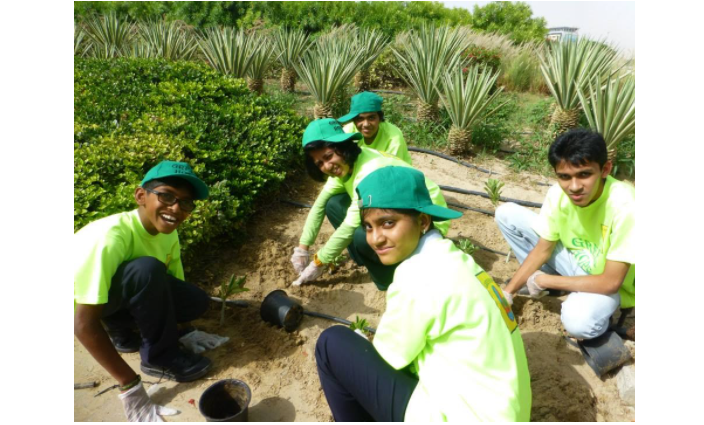
What does ‘sustainable schools’ mean?
A sustainable school is one which:
- minimizes its environmental impact and costs,
- works on improving health and wellness on the campus, and
- ensures effective environmental and sustainability education.
How does a school become sustainable?
It is important to adopt a multi-pronged approach to ensure that sustainability is integrated into all processes in school as much as possible. This includes:
- decreasing energy and water usage,
- reducing waste, and increasing recycling,
- reusing resources, and reducing costs wherever possible,
- encouraging uptake of sustainable practices amongst students,
- having an environmentally friendly infrastructure (e.g. solar panels), and
- segregating waste at source for recycling/composting by janitorial staff.
This is where the help of teachers becomes important.
How can teachers and administrative staff help with making schools more sustainable?

With the right knowledge, teachers can bring about sustainable changes in schools.
This provides the dual benefit of educating students on environmental responsibility and keeping costs low for schools by using resources effectively. Teachers should be encouraged to:
- integrate concepts like minimizing energy/water usage, recycling, etc., into their teaching, make it a part of the curriculum, and spread awareness about these concepts among students,
- make use of renewable energy (e.g. solar power) in classrooms to reduce costs over the long term,
- get the janitorial staff involved in segregating waste at source for recycling/composting, which will not only benefit the environment but also save money on the part of the school,
- encourage students to take up sustainable practices that are easy and accessible (e.g. composting at home),
- implement green team initiatives among students where they can learn about sustainable practices through hands-on experience, and
- switch to renewable sources of energy like solar power for campus lighting.
What role does corporate social responsibility play?
Schools need to be environmentally responsible as this will encourage students and teachers alike to follow suit. This also means minimizing harm to the environment, recycling where possible, and doing our bit towards a greener world. Corporate social responsibility (CSR) can therefore play an active role in helping schools become more sustainable.
Companies can work with schools to reduce their energy/water usage, waste generation, etc., which will enable them to save on costs and maintain a green campus. For example, companies that provide janitorial services for schools should do their best towards segregating waste at the source instead of merely collecting it together for disposal.
Corporate social responsibility will help schools with the following areas:
- reducing energy/water usage by providing better up-to-date equipment,
- recycling, e.g. electronic waste deposited at collection points near campus for recycling by corporate CSR teams,
- composting organic solid waste on school grounds to use it as manure in the future,
- reducing the amount of waste generated by providing eco-friendly plates, glasses, cutlery, etc., and promoting paperless classrooms with e-learning resources. By doing this, not only will there be less waste to handle but it will also encourage students towards using digital resources over print resources wherever possible.
- Corporate social responsibility can also help schools save on energy costs by providing solar power panels to generate electricity.
With the right approach, schools can become sustainable with the involvement of teachers, students, and CSR teams alike. This will ensure that every stakeholder involved has a positive impact on the environment and society at large.
Top 10 most sustainable schools in the world (and what we can learn from them!)

According to UI Green Metric Overall Rankings 2020, the top 10 sustainable schools in the world are:
- Wageningen University & Research, Netherland: This is one of the top universities in the Netherlands which has adopted measures like installing solar panels for generating electricity, constructing buildings with sustainable materials, and providing renewable energy-based transport to encourage its students while at the same time reducing costs.
- University of Oxford, United Kingdom: The main focus of the University of Oxford is on recycling, composting organic wastes to use as manure, and sustainable construction. All academic buildings have been constructed as eco-friendly as possible with minimal usage of materials with a long life span.
- University of Nottingham, United Kingdom: The water conservation efforts of the University of Nottingham help it reduce costs and become more sustainable. The university has implemented a program called ‘Water is Life’ with activities like inviting students for “plogging”, i.e. picking up garbage while jogging, and installing water-saving systems in toilets to encourage students towards becoming more responsible towards nature and themselves.
- Nottingham Trent University, United Kingdom: The efforts of Nottingham Trent University to become more sustainable include implementing smart meters for electricity, water, and gas in all buildings to check their usage in real-time. Additionally, there are plans in place to provide reusable razors in bathrooms across campus for students to avoid using disposable ones.
- University of California, Davis, USA: The University of California, Davis is one of the most sustainable in the world. It has taken many initiatives like promoting electric vehicles to reduce emissions, reducing water usage by providing low-flow plumbing devices, and encouraging best practices for daily tasks like showering and brushing teeth.
- Umwelt-Campus Birkenfeld (Trier University of Applied Sciences), Germany: The University of Applied Sciences has taken many sustainable initiatives like promoting solar energy and building an organic farm. The university also promotes and encourages cycling across campus to help students save on costs and become more environmentally conscious at the same time.
- The University of Groningen, Netherland: The University of Groningen has taken efforts to become more environmentally friendly by encouraging waste reduction, recycling organic wastes into fertilizer, and promoting solar panels as a source of energy.
- Leiden University, Netherland: The University of Leiden has always prioritized the improvement of the quality of life for its students by promoting sustainable development. It encourages student participation in sustainability initiatives like installing solar panels at their homes, using rainwater to water plants, and using public transport whenever possible.
- University College Cork, Ireland: The University College Cork is yet another example of how a university can become more sustainable and reduce costs. The initiatives taken by the university include installing solar panels, improving energy efficiency by replacing old equipment, and encouraging students to use public transport.
- Universita di Bologna, Italy: The University of Bologna has constructed buildings using environmentally-friendly materials with special attention to energy, water, and waste. The university has also taken steps like promoting cycling facilities for students to reduce their carbon footprint by encouraging sustainable living.
Sustainability indicators schools should focus on

- Responsible schools should aim for more green spaces, save the environment and use sustainable energy. They should pay attention to:
- The ratio of open space, forest vegetation, planted vegetation, and water absorption areas towards the total area should be more.
- Allot budget for introducing, operating, and maintaining sustainability efforts and activities.
- The campus should be made friendly for the disabled, people with special needs and/ or maternity care.
- The school campus should have safety, security as well as health infrastructure facilities for everyone – including students, academic staff, and administrative staff.
- Built medium-term or long-term plant, animal, and wildlife conservation facilities and develop food and agriculture resources.
2. Every university should encourage the use of energy-efficient appliances, have a policy of using renewable energy, reduce the use of electricity, promote conservation of energy, make green buildings, etc. Some of the things they should take care of are:
- Build smart buildings.
- Use energy-efficient appliances.
- Instance renewable energy sources on campus.
- Reduce electricity usage by each person and increase the use of renewable energy instead.
- Include green building regulations and guidelines in all construction and renovation plans.
- Make and implement programs to reduce greenhouse gas emissions.
- Make and implement plans to reduce the carbon footprint of each person.
- Come up with innovative and impactful university programs on climate change and contain the COVID-19 pandemic.
3. Campuses produced a lot of waste. Hence, organic and inorganic waste treatments, recycling programs, sewage disposal, and reducing the use of plastic and paper, etc. are important when it comes to creating a sustainable environment. Hence, the universities must do the following:
- Reduce the use of paper and plastic on their campuses.
- Recycle university waste and treat organic, inorganic, and toxic waste as per guidelines.
- Have a proper sewage disposal system.
4. Decreasing the use of water and making use of a water conservation program can help schools and universities protect the habitat. They should:
- Implement water conservation and recycling programs.
- Use water-efficient appliances.
- Increase consumption of treated water.
- Have proper handwashing and sanitation facilities to handle the pandemic situation sensibly.
5. Big campuses must use eco-friendly campus buses, encourage the use of bicycles and public transportation, and discourage the use of private motor vehicles. This can help them cut down on carbon emissions and air pollutions. Some of the things that can be done are:
- Limit the use of motorcycles or cars on the campus.
- Use zero-emission vehicles as shuttle service on campus.
- Limit or decrease the parking area inside the campus to discourage people from using private vehicles.
- Make pedestrian and bicycle paths on campus to encourage people to walk or cycle more.
6. Education and Research focused on environmental and sustainability issues is critical for our future. And schools need to take responsibility for this. Some of the things they can do are:
- Sustainability courses should be increased.
- More research funding should be allotted to sustainability research.
- Increase the number of scholarly publications, events, cultural activities, and student organizations related to sustainability and the environment.
- Maintain a sustainability website and publish a sustainability report to make students aware of different efforts, drives, and programs run by the university.
- Involve students in community services projects and encourage them to come up with startups related to sustainability.
If you need help with sustainability project ideas, we have the best online experts to assist you.



0 responses on "Sustainable Schools for Everyone: What it means and what needs to be done"